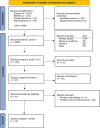Developing a Program Costs Checklist of Digital Health Interventions: A Scoping Review and Empirical Case Study
- PMID: 38530596
- PMCID: PMC11126496
- DOI: 10.1007/s40273-024-01366-y
Developing a Program Costs Checklist of Digital Health Interventions: A Scoping Review and Empirical Case Study
Abstract
Introduction: The rate of development and complexity of digital health interventions (DHIs) in recent years has to some extent outpaced the methodological development in economic evaluation and costing. Particularly, the choice of cost components included in intervention or program costs of DHIs have received scant attention. The aim of this study was to build a literature-informed checklist of program cost components of DHIs. The checklist was next tested by applying it to an empirical case, Mamma Mia, a DHI developed to prevent perinatal depression.
Method: A scoping review with a structured literature search identified peer-reviewed literature from 2010 to 2022 that offers guidance on program costs of DHIs. Relevant guidance was summarized and extracted elements were organized into categories of main cost components and their associated activities following the standard three-step approach, that is, activities, resource use and unit costs.
Results: Of the 3448 records reviewed, 12 studies met the criteria for data extraction. The main cost categories identified were development, research, maintenance, implementation and health personnel involvement (HPI). Costs are largely considered to be context-specific, may decrease as the DHI matures and vary with number of users. The five categories and their associated activities constitute the checklist. This was applied to estimate program costs per user for Mamma Mia Self-Guided and Blended, the latter including additional guidance from public health nurses during standard maternal check-ups. Excluding research, the program cost per mother was more than double for Blended compared with Self-Guided (€140.5 versus €56.6, 2022 Euros) due to increased implementation and HPI costs. Including research increased the program costs to €190.8 and €106.9, respectively. One-way sensitivity analyses showed sensitivity to changes in number of users, lifespan of the app, salaries and license fee.
Conclusion: The checklist can help increase transparency of cost calculation and improve future comparison across studies.
Plain language summary
Estimating program or intervention costs of digital health interventions (DHIs) can be challenging without a checklist. We reviewed scientific literature to identify key cost categories of DHIs: development, research, maintenance, implementation and health personnel involvement. We also summarized relevant information regarding resource use and unit cost for each of the aforementioned categories. Applying this checklist to Mamma Mia, a DHI aimed at preventing perinatal depression, we find that the total cost per user for Mamma Mia Self-Guided is €106.9 and for Mamma Mia Blended is €190.8. Our checklist enhances visibility of DHI cost components and can aid analysts in better estimating costs for economic evaluations.
© 2024. The Author(s).
Conflict of interest statement
The authors declare no conflicts of interest.
Figures
Similar articles
-
Methods, Indicators, and End-User Involvement in the Evaluation of Digital Health Interventions for the Public: Scoping Review.J Med Internet Res. 2024 May 31;26:e55714. doi: 10.2196/55714. J Med Internet Res. 2024. PMID: 38819891 Free PMC article.
-
Improving Predictability and Effectiveness in Preventive Digital Health Interventions: Scoping Review.Interact J Med Res. 2023 Jul 20;12:e40205. doi: 10.2196/40205. Interact J Med Res. 2023. PMID: 37471129 Free PMC article.
-
Digital Health Interventions for Depression and Anxiety Among People With Chronic Conditions: Scoping Review.J Med Internet Res. 2022 Sep 26;24(9):e38030. doi: 10.2196/38030. J Med Internet Res. 2022. PMID: 36155409 Free PMC article.
-
The Cost-Effectiveness of Digital Health Interventions on the Management of Cardiovascular Diseases: Systematic Review.J Med Internet Res. 2019 Jun 17;21(6):e13166. doi: 10.2196/13166. J Med Internet Res. 2019. PMID: 31210136 Free PMC article.
-
An Evaluation Service for Digital Public Health Interventions: User-Centered Design Approach.J Med Internet Res. 2021 Sep 8;23(9):e28356. doi: 10.2196/28356. J Med Internet Res. 2021. PMID: 34494965 Free PMC article.
Cited by
-
Economic Evaluation Methodologies of Remote Patient Monitoring for Chronic Conditions: Scoping Review.J Med Internet Res. 2025 Jul 4;27:e71565. doi: 10.2196/71565. J Med Internet Res. 2025. PMID: 40614106 Free PMC article.
-
Mapping methodologies for economic assessment of digital health technologies: a scoping review protocol.BMJ Open. 2025 Aug 1;15(7):e099933. doi: 10.1136/bmjopen-2025-099933. BMJ Open. 2025. PMID: 40750290 Free PMC article.
-
Expanding two-way texting for post-operative follow-up: A cost analysis of the implementation and scale-up in routine voluntary medical male circumcision settings in South Africa.PLOS Glob Public Health. 2025 Apr 22;5(4):e0004049. doi: 10.1371/journal.pgph.0004049. eCollection 2025. PLOS Glob Public Health. 2025. PMID: 40261872 Free PMC article.
-
Costs and Outcomes of a Therapist-Guided Internet-Delivered Cognitive Behavioral Therapy: Multicenter Observational Study.J Med Internet Res. 2025 Jul 28;27:e73067. doi: 10.2196/73067. J Med Internet Res. 2025. PMID: 40720811 Free PMC article.
References
Publication types
MeSH terms
Grants and funding
LinkOut - more resources
Full Text Sources
Miscellaneous



